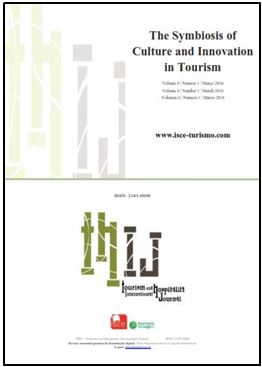Profile of the national Alentejo online visitor- Analysis of the official tourism website using GA
DOI:
https://doi.org/10.57883/thij6(1)2016.30282Palavras-chave:
Google Analytics, Turismo, Internet, Alentejo, WebsiteResumo
A crescente utilização da Internet pelas empresas e consumidores tornou a Internet numa importante fonte de dados para suporte à tomada de decisão em diferentes áreas do conhecimento. O turismo é um dos setores que mais impactos sofre com as mudanças introduzidas pela Internet. Essas alterações foram sentidas em vários aspetos, sendo um deles a necessidade e possibilidade de aceder a informação turística relevante e disponível em tempo real, permitindo a otimização da estratégia de marketing digital. O objetivo principal deste artigo é mostrar que os dados da Internet, nomeadamente do Google Analytics [GA], fornecem informação sobre o perfil do visitante nacional do destino Alentejo, com base no website oficial do Turismo do Alentejo. O estudo foca-se, essencialmente, no movimento e visitas dos portugueses no mais importante website do Turismo do Alentejo. Os resultados mostram que os dados do GA podem contribuir para conhecer, em tempo real, o perfil do visitante do Alentejo. Além disso, podem servir de suporte ao processo de tomada de decisão ao marketing das organizações de gestão de destinos [DMO].
Referências
Buhalis, D. (2003). eTourism-Information technology for strategic tourism management. London: Prentice Hall.
Buhalis, D., & O’Connor, P. (2006). Information Communication Technology – Revolutionizing Tourism. In Buhalis, D., & Costa, C. (Eds.), Tourism Management Dynamics - Trends, management and tools (pp. 196-209). Oxford: Elsevier Butterworth-Heinemann.
Cai, L. A., Feng, R., & Breiter, D. (2004). Tourist purchase decision involvement and information preferences. Journal of Vacation Marketing, 10(2), 138-148. doi: 10.1177/135676670401000204.
Crouch, G. (2000). Services Research in Destination Marketing: A Retrospective and Prospective Appraisal. International Journal of Hospitality & Tourism Administration, Vol. 1(2), 65-85. doi: 10.1300/J149v01n02_04.
Cutroni, J. (2010). Google Analytics. USA: O’Reilly Media, Inc..
Dinis, M. G., Costa, C. & Pacheco, O. (2012). Google Analytics as a tool for understanding visitors behaviour: the website of Alentejo as a tourist destination case. Revista Turismo & Desenvolvimento/Journal of Tourism and Development, 17/18, 32 1-331 doi: 1645-9261 ISSN 1645-9261
Doolin, B., Burgess, L., & Cooper, J. (2002). Evaluating the use of the Web for tourism marketing: A case study from New Zealand. Tourism Management, 23(5), 557–561. doi: 10.1016/S0261-5177(02)00014-6.
Eurostat. (2014a). Enterprises - level of Internet access (NACE Rev. 2) [isoc_ci_in_en2]. Eurostat. Retrieved from http://bit.ly/1kkZdHl. Accessed 01 de jun, 2014.
Eurostat. (2014b). Enterprises - computers: devices and communication systems (NACE Rev. 2) enterprises having a website or homepage [isoc_ci_cd_en2]. Eurostat. Retrieved from http://bit.ly/1oyF3ct. Accessed 01 de jun, 2014.
Expedia, Inc. All. (2010). New Research from Expedia Media Provides Insight into Destination Marketing Trends. Expedia.com Media Room. Retrieved from http://bit.ly/1qRVSh7 . Accessed 01 jan, 2015.
Google (2015). Google Analytics. Retrieved from http://bit.ly/1hZKKxw.
Law, R., Leung, R., & Buhalis, D. (2009). Information technology applications in hospitality and tourism: A review of publications from 2005 to 2007. Journal of Travel & Tourism Marketing, 26(5-6), 599-623. doi: 10.1080/10548400903163160.
Moreno de la Santa, J. G. (2011). A World Tourism Organization Affiliate Members: AM-reports – Technology in Tourism (Vol 1). Retrieved from http://bit.ly/1hauLXX. Accessed 5 aug, 2014.
Observatório Regional do Turismo do Alentejo. (2013). Caracterização da Procura Turística - Alentejo. Retrieved from http://bit.ly/1pNo6IK. Accessed 10 mar, 2015.
Palmer, J. W. (2002). Web site usability, design, and performance metrics. Information systems research, 13(2), 151-167.
Tnooz. 2012. Destinations failing to make most of technology to attract and engage visitors. Tnooz. Retrieved from http://bit.ly/1o13CBg. Accessed 01jul, 2014.
Tonkin, S., Whitmore, C., & Cutroni, J. (2010). Performance Marketing with Google Analytics: Strategies and Techniques for Maximizing Online ROI. Indianapolis: John Wiley Publishing, Inc.
Travelport. (2010). The Well Connected Traveller - the changing face of today's travel consumers. Retrieved from http://bit.ly/1vONFOt. Accessed 01 mar 2015.
Turismo de Portugal. (2013). Anuário das estatísticas do turismo 2012. Retrieved from http://bit.ly/ZKil7H. Accessed 03 may, 2014.
Web Analytics Association. (2011). The Official WAA Definition of Web Analytics. In Dinis, M. G., Costa, C. & Pacheco, O. (2012). Google Analytics as a tool for understanding visitors behaviour: the website of Alentejo as a tourist destination case. Revista Turismo & Desenvolvimento/Journal of Tourism and Development, 17/18, 32 1-331 doi: 1645-9261 ISSN 1645-9261.
Downloads
Publicado
Como Citar
Edição
Secção
Licença
Direitos de Autor (c) 2023 This work is licensed under a Creative Commons - Attribution 4.0 International (CC BY 4.0)

Este trabalho encontra-se publicado com a Licença Internacional Creative Commons Atribuição 4.0.
Este trabalho encontra-se publicado com a Licença Internacional Creative Commons Atribuição 4.0.






